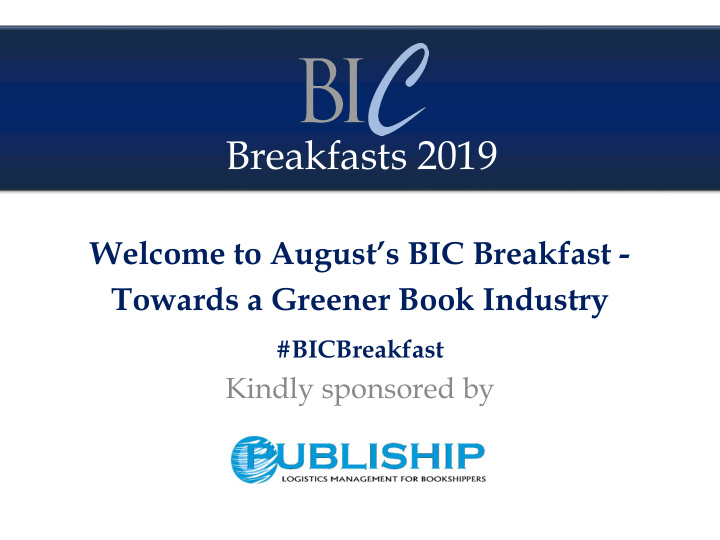



Breakfasts 2019 Welcome to August’s BIC Breakfast - Towards a Greener Book Industry #BICBreakfast Kindly sponsored by
What is a BIC Breakfast?
BIC Committees Digital Supply Chain Libraries Metadata Physical Supply Chain
Regular BIC Events BIC Breakfasts (monthly) Networking Events including our annual BIC Bash (12 th November 2019) Building a Greener Business Seminar at London Book Fair (12 th March 2020)
Engagement Extensive Training Programme Social Media: @BIC1UK @KarinaLuke @BIC_LCF Connect with us on Twitter, Facebook and LinkedIn.
Over to Dave…
Towards A Greener Book Industry Sponsored by
WE SHIP BOOKS
Enjoy the presentations! Sponsored by
Over to Carly & Nick…
BOOK CHAIN PROJECT Building better supply chains for books 15 th August 2019
The issues
Working together
Printer Manufacturer Publisher (paper, ink…)
MILL ASSESSMENTS Understanding how mills are mitigating illegal logging and forest clearing risk in their supply chains
ENVIRONMENTAL QUESTIONNAIRE • Understanding how suppliers are managing key environmental issues • Gather key data for publisher reporting
PLASTICS GUIDE • Understanding plastic – properties, challenges, busting some myths and recommendations
PLANS FOR THE YEAR AHEAD • Mill assessments continue on the ground in Europe and Asia • Workshop convening suppliers and manufacturers in China • Re-vamped environmental questionnaire extended to mills • Developing a ‘design guide’ for environmentally -conscious • Special project: A collective response to shrink wrap
GET IN TOUCH bookchainproject.com info@bookchainproject.com carly.griggs@carnstone.com
Over to Neil…
THE BIC BREAKFAST Towards a Greener Book Industry August 2019
Just a thought. Over 40% of all global plastic usage is in packaging. “Plastic will be the main ingredient of all our grandchildren’s recipes.” Anthony T Hincks “The greatest threat to our planet is the belief that someone else will save it.” Robert Swan 31
Penguin Random House Services – Frating near Colchester We studied our total plastic usage figures within our operation in 2018. Our most considerable usage was in plastic shrink wrap and carton filling. Our target was to try and achieve a minimum of a 75% reduction throughout 2019. So far….. We have achieved a 47% reduction. 32
So how have we achieved it? Investment in multi use pallet lids. & site shredding equipment to recycle our transit cardboard packaging 33
But it’s more than just us. • Internally: a. Office areas, replacing plastic cup water dispensers and straws. b. On-site canteen, single use plastic food cartons and plastic KFS. c. Power reduction initiatives, LED lights, light sensors, car park timer switches. • Externally: a. Printers, pallet lids rather than shrink wrap, binders pack wrapping. b. Container handlers, pallet lids rather than shrink wrap. c. Transportation companies, planning loads to reduce excess mileage. d. 3PL off site locations. A green partnership to help reduce plastic usage and wastage. 34
After extensive trials. We are seriously investing to make a difference. And want our suppliers and customers to join us on our journey. 35
Over to Dave…
What is the Shipping Industry doing towards improving it’s environmental impact?
Emissions Ballast
OOCL Hong Kong 400 metres long, 58.5 metres wide Containers stowed 8 high above deck, 11 high below – making the ship around the height of a 20 storey building Carries equivalent of 21,430 20’ containers – placed end to end they would stretch 81 miles
40% more fuel efficient than ships of 10 years ago
‘Slow Steaming’ Reduce speed by 10% - save 35% of fuel
Emissions from Containerships Carbon Dioxide (CO 2 ) Sulphur Oxide (SO x ) Nitrogen Oxide (NO x )
If International Shipping was a country, it would sit 7 th in the world table of emissions based on 2017 figures Rank Country 2017 kton 1 China 10877218 2 United States 5107393 3 India 2454774 4 Russia 1764866 5 Japan 1320776 6 Germany 796528.9 7 International Shipping 677247.8
Emissions from Containerships International shipping accounts for 2.1% of all CO 2 emissions
International Maritime Organisation (IMO) has a target to reduce CO2 Emissions 50% by 2050 and for ‘emission reduction to begin as soon as possible’ Some have criticized this as ‘unambitious’ but these measures were not unanimously approved, with 9 member-states voting against
Low Sulphur Options Low Sulphur Fuel Exhaust Gas Cleaning System (Scrubbers) Liquified Natural Gas Expensive & Somewhat unproven in Cheaper, but produces maritime conditions. Only produces emissions 1% of maritime fleet has emissions landside during fitted them landside during production production. Not widely available All options are likely to increase freight costs
Other Modes of Transport CO2 emissions produced moving one tonne of cargo over 5000 kilometres distance Container Ship 60kgs Diesel Train 97kgs Truck 400kgs Air freight 3302kgs 0 500 1000 1500 2000 2500 3000 3500
Ballast Ships have tanks which they fill with sea water to trim the ship Provides stability in rough conditions Balances the ship during loading and unloading Compensates for fuel usage
Ballast Water Management Convention Came into effect in 2017 D1 Standard: Requirement to discharge ballast at least 200 miles from land, in seas at least 200 metres deep D2 Standard: Performance standard specifying type and amount of viable organisms allowed to be discharged. All new ships must comply with this standard
The world’s first electric cargo ship is now operating on the Pearl River in China.... It can sail 50 miles on one charge, and can re- charge in 2 hours…. It is used to carry coal to a power station!
Thanks for listening For more information about our Company and services, go to
Any questions?
Thank you for attending August 2019’s BIC Breakfast: Towards a Greener Book Industry Alaina-Marie Bassett Business Manager Book Industry Communication Ltd 0207 255 0513 Alaina-Marie@bic.org.uk
Recommend
More recommend